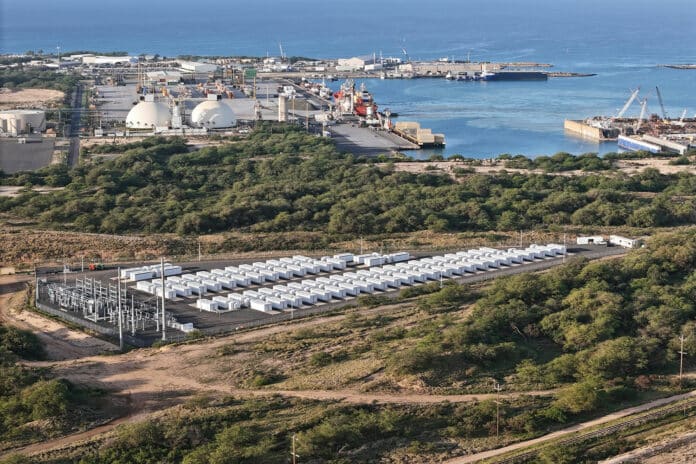Plus Power has recently launched its Kapolei Energy Storage (KES) facility in Oahu, Hawaii. This project is considered to be the most advanced grid-scale battery energy storage system in the world, helping transition the state’s electric power from coal and oil to solar and wind.
The KES battery project is located on 8 acres of industrial land on the southwest side of Oahu near Honolulu and uses 158 Tesla Megapack 2 XL lithium iron phosphate batteries, each roughly the size of a shipping container. It offers the grid 185 megawatts of total power capacity and 565 megawatt-hours of electricity, acting as an electrical “shock absorber” often served by combustion-powered peaker plants that take several minutes to come online. The KES battery project responds in just 250 milliseconds, providing a more efficient and reliable solution. This rapid response time ensures stability for Oahu’s isolated island grid.
“KES is an important part of a portfolio of resources that work together to provide reliability and energy security on Oahu’s isolated island grid,” said Jim Alberts, senior vice president and chief operations officer of Hawaiian Electric. “Energy storage technology that responds quickly to constantly changing conditions is an essential tool for us to use to manage the grid and operate it as efficiently as possible.”
“This is the first time a standalone battery site has provided grid-forming services at this scale – this is a critical application for high renewable penetration grids supplied by 185 MW of Megapack inverters,” said Mike Snyder, Sr Director, Tesla Megapack.
Hawaiian Electric has been curtailing large volumes of existing utility-scale solar and wind to keep the electric system in balance due to the abundance of customer-sited solar power.
The KES battery plant will help reduce the curtailment of renewable energy by 69% and integrate 10% more new utility-scale renewables than previous models had allowed. This will allow for the continued growth of individually-owned renewables such as rooftop solar. Additionally, the project is estimated to reduce electric bills by an average of $0.28 per month over a 20-year contract life.
The battery plant’s specifications include 135 MW / 540 MWH of capacity and energy, along with 50 MW/25 MWH of additional ‘fast frequency response,’ which can aid in keeping the electric grid stable. The plant also has ‘Virtual inertia,’ which replicates the power-smoothing function of a spinning turbine. Additionally, the ‘Black start’ capabilities of the plant can support grid recovery in the event of a blackout.
The KES plant interconnects near three of Hawaiian Electric’s critical power generation facilities, thereby enabling KES to support the reboot of those power plants in the event of an island-wide emergency, which is also known as ‘black start’ capability.
“This is a landmark milestone in the transition to clean energy,” said Brandon Keefe, Plus Power’s Executive Chairman. “It’s the first time a battery has been used by a major utility to balance the grid, providing fast frequency response, synthetic inertia, and black start. This project is a postcard from the future – batteries will soon be providing these services, at scale, on the mainland.”
The KES batteries will play a crucial role in replacing the grid capacity previously provided by a coal power plant located close to Oahu, which used to generate up to 20% of the electricity on the island. Oahu is home to a significant population of Hawaii’s residents as well as Army, Navy, Air Force, and Marine Corps bases that rely heavily on a stable and consistent power supply. It’s worth noting that the coal plant ceased operations in September 2022.
